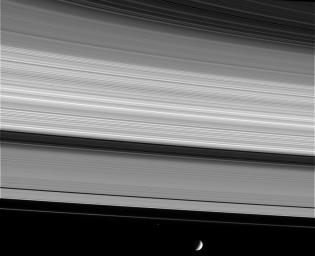
|
Bound to Saturn
- Click the image above for a larger view
- Full-Res JPEG (1024 x 832) (74.0 kB)
- Full-Res TIFF (1024 x 832) (655.7 kB)
Caption:
Saturn's complex rings are both an intriguing scientific puzzle and a supreme natural wonder. This view shows, from upper right to lower left, the thin C ring, multi-toned B ring, the dark Cassini Division, the A ring and narrow F ring.
At the bottom, Saturn's moon Mimas (398 kilometers, or 247 miles across) orbits about 45,000 kilometers (28,000 miles) beyond the bright core of the F ring. The little moon is heavily cratered and is thought to be largely composed of water ice. The bright speck just outside of (below) the F ring is the shepherd moon Pandora (84 kilometers, or 52 miles across).
The image was taken in visible light with the Cassini spacecraft narrow angle camera on Jan. 19, 2005, at a distance of 1.8 million kilometers (1.1 million miles) from Saturn. The image scale is 11 kilometers (7 miles) per pixel. Pandora was brightened by a factor of seven to aid visibility.
Background Info:
The Cassini-Huygens mission is a cooperative project of NASA, the European Space Agency and the Italian Space Agency. The Jet Propulsion Laboratory, a division of the California Institute of Technology in Pasadena, manages the mission for NASA's Science Mission Directorate, Washington, D.C. The Cassini orbiter and its two onboard cameras were designed, developed and assembled at JPL. The imaging team is based at the Space Science Institute, Boulder, Colo.
For more information about the Cassini-Huygens mission, visit http://saturn.jpl.nasa.gov and the Cassini imaging team home page, http://ciclops.org .
Cataloging Keywords:
| Name | Value | Additional Values |
|---|---|---|
| Target | Saturn | C Ring, Cassini Division, Mimas, Pandora, Saturn Rings |
| System | Saturn | |
| Target Type | Planet | Gap, Ring, Satellite |
| Mission | Cassini-Huygens | |
| Instrument Host | Cassini Orbiter | |
| Host Type | Orbiter | |
| Instrument | Imaging Science Subsystem (ISS) | |
| Detector | Narrow Angle Camera | |
| Extra Keywords | Crater, Grayscale, Visual, Water | |
| Acquisition Date | ||
| Release Date | 2005-02-16 | |
| Date in Caption | 2005-01-19 | |
| Image Credit | NASA/JPL/Space Science Institute | |
| Source | photojournal.jpl.nasa.gov/catalog/PIA06586 | |
| Identifier | PIA06586 | |
